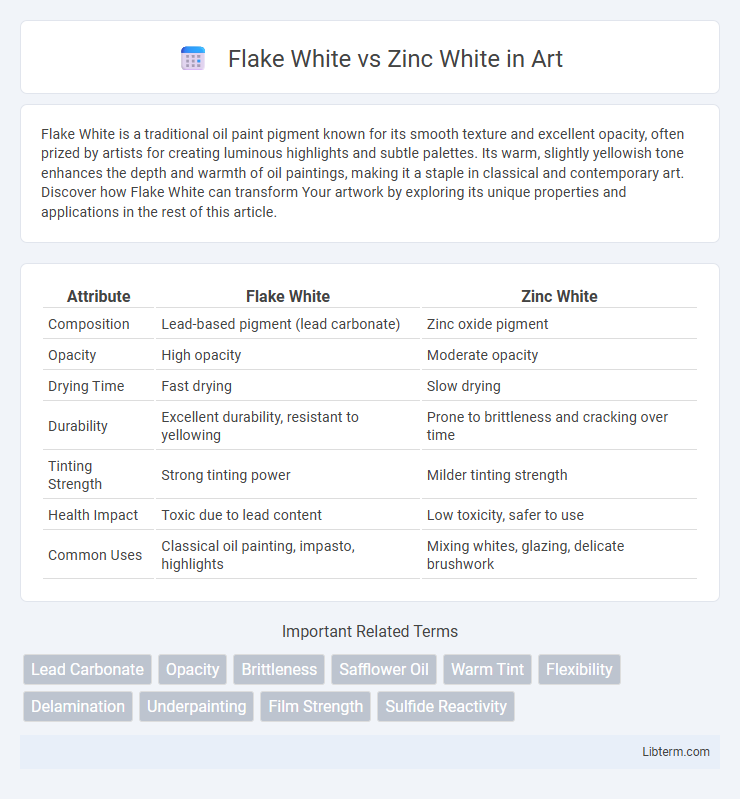Flake White is a traditional oil paint pigment known for its smooth texture and excellent opacity, often prized by artists for creating luminous highlights and subtle palettes. Its warm, slightly yellowish tone enhances the depth and warmth of oil paintings, making it a staple in classical and contemporary art. Discover how Flake White can transform Your artwork by exploring its unique properties and applications in the rest of this article.
Table of Comparison
| Attribute | Flake White | Zinc White |
|---|---|---|
| Composition | Lead-based pigment (lead carbonate) | Zinc oxide pigment |
| Opacity | High opacity | Moderate opacity |
| Drying Time | Fast drying | Slow drying |
| Durability | Excellent durability, resistant to yellowing | Prone to brittleness and cracking over time |
| Tinting Strength | Strong tinting power | Milder tinting strength |
| Health Impact | Toxic due to lead content | Low toxicity, safer to use |
| Common Uses | Classical oil painting, impasto, highlights | Mixing whites, glazing, delicate brushwork |
Introduction to Flake White and Zinc White
Flake White, traditionally made from lead carbonate, offers a rich, opaque coverage with excellent durability, making it favored in oil painting for its fast drying time and warm, slightly yellowish hue. Zinc White, composed of zinc oxide, provides a cooler, more transparent finish with slower drying properties, ideal for glazing and mixing without overpowering other pigments. Artists choose Flake White for its buttery consistency and strong opacity, while Zinc White is preferred for delicate layering and reducing toxicity in paint formulations.
Historical Background of White Pigments
Flake White, also known as lead white, has been used since antiquity, valued for its warm tone and strong opacity, making it a staple in classical European oil painting. Zinc White emerged in the 19th century as a safer alternative to toxic lead-based pigments, offering a cooler, more transparent white with slower drying properties. Both pigments played pivotal roles in the evolution of painting techniques, influencing artists' choices and the durability of artworks throughout history.
Chemical Composition Comparison
Flake White, primarily composed of basic lead carbonate (2PbCO3*Pb(OH)2), offers excellent opacity and warm tonal qualities inherent to its lead-based composition. Zinc White consists of zinc oxide (ZnO), providing cooler, less opaque properties with increased brittleness in paint films. The chemical distinctions between lead carbonate in Flake White and zinc oxide in Zinc White significantly influence their drying times, durability, and suitability for different artistic applications.
Opacity and Tinting Strength Differences
Flake White exhibits high opacity and strong tinting strength, making it ideal for creating bold, solid coverage in oil painting. Zinc White, in contrast, has lower opacity and weaker tinting strength, producing more transparent layers ideal for subtle glazing techniques. Artists choose Flake White for rapid coverage and Zinc White for delicate color mixing and translucency effects.
Handling and Working Properties
Flake White offers a buttery consistency and superior opacity, allowing for smooth blending and easier manipulation in layering techniques, making it ideal for traditional oil painting. Zinc White dries slower with a thinner, more brittle film, which can cause cracking over time but provides excellent transparency and subtle mixing qualities. Artists often prefer Flake White for its durability and handling ease, while Zinc White suits delicate glazing and fine detail work due to its cooler tone and softness.
Drying Time and Film Durability
Flake White, a lead-based pigment, dries faster due to its chemical properties promoting quicker oxidation, making it ideal for artists seeking rapid drying times. Zinc White dries slower, often requiring multiple weeks to fully cure, which can affect project timelines. In terms of film durability, Flake White forms a more flexible and resilient paint film resistant to cracking, whereas Zinc White produces a harder but more brittle film prone to brittleness and potential crazing over time.
Color Stability and Aging
Flake White exhibits superior color stability and ages with a warm, creamy patina due to its lead-based composition, making it favored by artists for traditional oil painting techniques. Zinc White, while offering a cooler, brighter tone, is prone to brittleness and microcracking over time, leading to potential yellowing and reduced longevity in paint films. The pigment's chemical properties significantly influence the aging process, with Flake White maintaining structural integrity better than Zinc White in long-term artwork preservation.
Health and Safety Considerations
Flake White contains lead, which poses significant health risks such as lead poisoning through inhalation or skin contact, making proper ventilation and protective gear essential. Zinc White is a safer alternative, as it is free from heavy metals and generally non-toxic, but it can cause skin irritation or sensitization in sensitive individuals. Both whites require careful handling, avoiding ingestion and prolonged exposure to dust or mist during application and cleanup.
Best Uses and Applications in Painting
Flake White, known for its warm, opaque coverage and strong tinting strength, is ideal for oil painting techniques that require rich texture and vibrancy, such as impasto and underpainting. Zinc White offers a cooler, more transparent finish with slower drying time, making it suitable for glazing, mixing with other colors to lighten without overpowering, and detailed work where subtle layering is essential. Artists often prefer Flake White for traditional portrait and landscape paintings while choosing Zinc White for fine, detailed applications and delicate color blending.
Final Thoughts: Choosing the Right White
Flake White offers superior opacity and warmer tones ideal for traditional oil painting techniques, while Zinc White provides a cooler, more transparent finish suitable for glazing and subtle transitions. Artists seeking robust coverage and a vintage palette often prefer Flake White, whereas those prioritizing delicate light effects or working with watercolors may opt for Zinc White. Selecting between them depends on the desired texture, drying time, and color temperature in the final artwork.
Flake White Infographic

 libterm.com
libterm.com